The Beleaguered IBM PC in History
August 12th, 2011 by Benj Edwards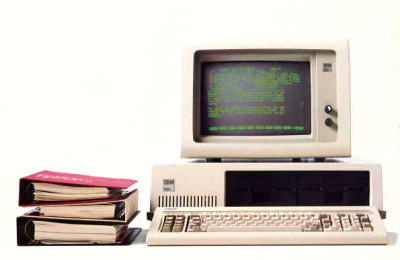
From the 1990s until very recently, the press has been generally unkind to the achievements of the first IBM PC. Due to the PC platform’s utter dominance of the personal computer market, popular accounts of personal computer history commonly paint IBM as the slow, lumbering, clueless enemy while cheering on spunky underdogs like Apple. I’m not even going to cite specific examples: Google “computer history.” Read. You will see it.
But that perspective is not fair at all. IBM truly pulled off something smart, savvy, and remarkable in designing the IBM PC 5150 (and the machines that followed it, into the PS/2 era). With the 5150, a team of 12 people took the machine from concept to shipping product in less than a year. And yet many focus on how IBM supposedly lost its way.
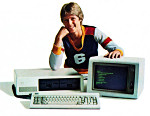 Much ballyhoo has been made, for example, about how IBM lost its grip on the PC’s direction as clones flooded the market. From a different perspective, that runaway-freight-train-of-a-platform is a success story for IBM.
Much ballyhoo has been made, for example, about how IBM lost its grip on the PC’s direction as clones flooded the market. From a different perspective, that runaway-freight-train-of-a-platform is a success story for IBM.
While Big Blue lost market share to clone manufacturers, you have to keep in mind that IBM’s percentage shrank as the market size exploded. IBM fostered a rich PC standard that it kept reaping until it sold its PC division to Lenovo in 2004. IBM may not have kept steering the ship, but they sure made a lot of money in the cargo hold.
And if you think IBM’s influence on the PC standard ended in the early 1980s, think again. Real history is not so cut-and-dry. The PS/2 era (which dawned in 1987) gave us stalwarts like the PS/2 mouse/keyboard ports and, ah yes, that minor display technology called VGA. You can also thank the 1990s ThinkPad line for its part in streamlining the modern laptop.

The popular narrative of IBM vs. Apple in the 1980s, with its strong contrasts of Good vs. Evil and Hero vs. Villain was largely a creation of Apple’s marketing department. The image of Apple’s David verses IBM’s Goliath got repeated so many times that the press started using the supposed rivalry as the basis of dramatic stories. Humans need narratives to make sense of history, and writers have forced the PC market story into that archetypal mold.
Sure, IBM and Apple competed for dollars — and they may have even done it vigorously — but business is business. It’s not swashbuckling. The first thing you learn when actually studying computer history (i.e. interviewing folks) is that just about no one involved in creating these products thinks they were doing something so incredibly amazing that it should be turned into a movie. They were just doing their jobs, developing good products, and trying to make money like everyone else. When the project was over, they moved on to other things. That story is incredibly boring if you don’t dramatize it.
By using the IBM PC for a week for a recent article, I learned firsthand that the original PC really was an amazing machine for its time. It wasn’t just a generic box that happened to have an IBM logo on it, as some people argue. Sure, it didn’t have flashy graphics or a GUI, but it was solid, reliable, well-designed, and it was definitely the most qualified personal computer for getting work done in 1981. There is a reason it became a standard, after all — everyone imitated it, and they imitated it because it was amazing.


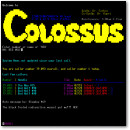
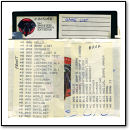

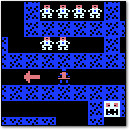
August 12th, 2011 at 3:25 pm
No, it wasn’t amazing. It was an experiment that went wild, and almost sunk IBM. PCs undercut mainframes while IBM blithely continued pushing them, and clone makers undercut IBM. If they hadn’t been sitting on a pile of several billion dollars, which gave them time to redefine themselves, they would have disappeared from sight. The fact that the PC carried the IBM logo is what made it acceptable in the business world, and when prices came down, it was natural for business people to buy the same kind of system at home. No learning curve, and they could shuttle work to and from home. The PC wasn’t the best piece of hardware, and DOS certainly wasn’t the best operating system. But “IBM” was the best logo to have on the front of the box.
August 12th, 2011 at 6:59 pm
Your mentality, Richard, is exactly what I am speaking against in this post.
The IBM PC was amazing, and it was more than just a box with an IBM logo on it. I know this because of two reasons: first, I own over 200 different computers, and I can compare them to the IBM PC experience. In my opinion, formed by using the first PC extensively, the 5150 provided the best productivity experience from a 1981 or earlier computer in my collection. It really was that good, and I have no grudge against any machine of any time period.
Two, I have read at least half a dozen reviews of the PC in 1981 (you can read some of them here) and the reviewers almost unanimously gave the 5150 high praise. The tech press of the day were impressed — not just by the IBM logo — and they were the most jaded lot out there. That says a lot.
It was only about a decade after the success of the PC standard — and the enormous monopoly of Microsoft — that it became popular to publicly dismiss the IBM PC as a lucky fluke and to retroactively claim that IBM was incompetent at managing its PC line, as you just did. IBM stewarded the PC line as well as could be expected, in my opinion, throughout the 1980s. Sure, they had an uninspired desktop design period from the 1990s and beyond, but that doesn’t diminish their earlier achievements. A lot of marketing FUD put out there by Apple and competitors helped create that IBM-bashing (and later Microsoft-bashing) mindset.
And as for the PC being a lackluster collection of hardware and software — The first PC seems like a generic and uninspired design to people now because it is the basis of everything we are currently familiar with about PCs. It’s easy to insult DOS as a CP/M rip-off. The fact is that DOS worked well, and the PC was a fast and very capable machine for its era.
IBM did achieve something great with the first PC, and it is time to stop dismissing that machine’s design, execution, and rightful place in history just because it created a wildly successful standard. Whether the PC line interfered with IBM’s mainframe market is irrelevant to the fact that IBM created a well-designed, very capable, very successful PC with the 5150.
August 13th, 2011 at 12:34 am
The IBM PC is a nice piece of hardware in many ways, and it was no doubt critical in getting PCs accepted by large business institutions. Richard is right though. IBM’s profit was based on big sales and service contracts for every business using an IBM PC. They pushed on with their old sales model, being quite successful in banks and government, while the clone makers flourished and took over.
Did IBM misstep with the PC? If their plan was to completely control the market like they did with mainframes, then yes, they did misstep. But if the goal was to produce a widely adopted platform that would become the business standard for years to come, then no, they did not misstep at all.
The PC is only one chapter in IBM’s long 100 year history.
August 14th, 2011 at 2:28 am
I guess its the sheer inelegance of the IBM PC design that rankled. Here was a machine build like a high end S100 CP/M machine with a barely better processor and a cut-down applelike bus. The 16k cassette version was a joke, way overbuilt for the home market with a stratospheric price. A year later Sinclair would introduce the ZX Spectrum a design using ULA (Uncommitted Logic Array) chips to reduce the chip count and keep costs down. I don’t think a penny was spent keeping the costs down on the PC.
The IBM PC, it could have been so much less.
August 14th, 2011 at 10:33 am
In the 80’s it was IBM with it’s IBM PC. Can we say the same thing today for Apple with the iPad?
August 14th, 2011 at 11:26 am
Jeremy,
There really is no fair comparison between the Sinclair ZX Spectrum and the IBM PC 5150.
Sinclair created the Spectrum specifically for a very low-end of the home PC market. It was well-designed and very successful for that application.
The PC was designed for the low-mid range business PC market (yes, the 16k home version of the 5150 wasn’t realistic, but IBM learned from it and refocused the 5150 toward business). It too was well-designed and successful for that application
Regarding the PC’s high price compared to the Spectrum (or an Atari 800, or TRS-80 CoCo, or VIC-20, etc), you really got what you paid for. The IBM was a capable, advanced machine for its time. It could handle a lot of RAM, it packed a fast processor, included a highly regarded (yet slightly flawed) keyboard, and provided very sharp text and graphics display options. It was build like a tank; IBM built it to last, and you’re right — they didn’t cut corners when it came to including high-quality components. Mine still works quite well, 30 years later, after I replaced a single bad RAM chip.
The Spectrum was built to be manufactured for very cheap and to sell in mass quantities. Its hardware wasn’t designed for serious business work, rather for home tinkering and gaming by home consumers. Magazines of the day split up the expensive business machines from the low-cost home PCs and rarely compared them for this reason — they were worlds apart in design, intended purpose, functionality, and price.
—
All that being said, I think it’s easy for some folks to be bitter about the PC and the PC platform because it swept dozens of other, very capable computers out of the market. People invested a lot, physically and emotionally in their platforms of choice (think Atari vs. Commodore wars, etc.), and it’s easy to hate IBM and Microsoft for destroying the diversity of the 1980s PC market.
But I think that market shakeout was bound to happen some time, and I don’t think we would have enjoyed the same level of astronomical progress in PC tech we’ve seen over the last 30 years without a common standard. That common standard meant most companies could build off of each other’s work toward a unified goal (a faster, better PC), instead of building against each other by promoting 15 incompatible architectures.
Great comments, guys. Very thoughtful. Thanks for taking the time to read my thoughts.
November 28th, 2012 at 3:11 pm
I realize I am rather late here but I wanted to chip in and say that the 5150 was a great machine. I got one probably third hand way back in my youth after it was considered “outmoded” for a couple of years. It did everything I asked it to do and more.
Yeah, it was a boat anchor is size and weight but it survived a fall down two sets of stairs (it was heavy and I dropped it) and only took a chunk out of two stairs. Powered and worked right through the paint scrape it suffered.
Benj I am jealous you that you still have a working model of this great machine as mine finally did die after daily use way back in 1999 after me having it only about 7 years. A slew of clones were owned during that time, including Packard Bell and a number of Compaq’s that I still own and use. I wish I had another one of these great machines.
December 10th, 2012 at 9:42 am
I liked this article.
my dad had this pc when I was a teenager. I used to play on it afterschool.
It introduced me to computing and was a major influence in my career today as a software engineer. This computer was not a good pc, for me it was the greatest pc design ever and layed the foundation for PC’s for decades. It was the “model T” of computers. I dont think i have ever gotten as much joy out of any pc today as much as i did out of that IBM pc. Played my first MS flight simulator on it, played starflight, leisuresuit larry, Balance of Power. even got my first virus (“your pc is stoned”). you always remember your first. 😉
There is even a company that makes modern keyboards with the heavy click-clack of the original IBM keyboards today. We miss that green hue of a terminal that so many old school developers simulate it’s look on linux terminals.
I miss that pc.
January 4th, 2013 at 5:55 am
Thank you for the article. I have the same opinion. I used many old computers and some of them I have still at home. Last year I was paid for helping lenovo with one (czech) museum project and had an original 5150 at home for a while. I was quite surprised how comfortable is the original keyboard (even after 30 years) and how easy to read is the long-persistent phosphor monochrome monitor (720x350px MDA text-mode). It was pleasure to work with it. From ergonomic point of view modern computers are not much better. This is something that I can’t say about the most 80s computers.